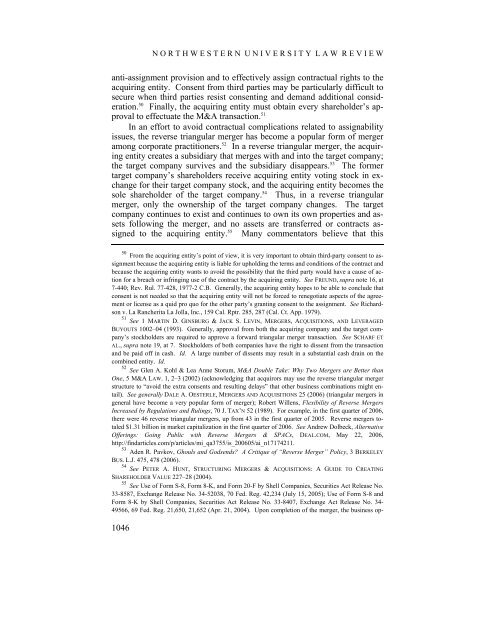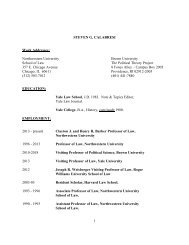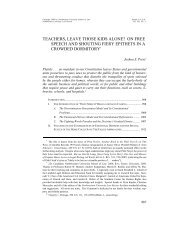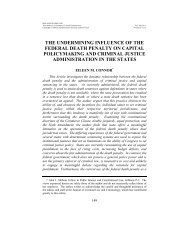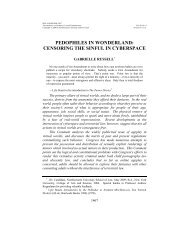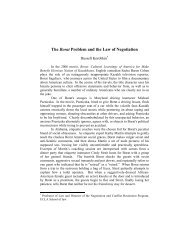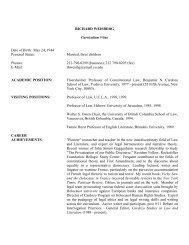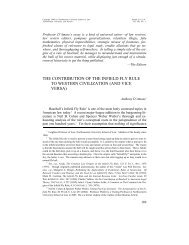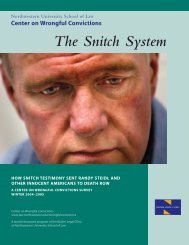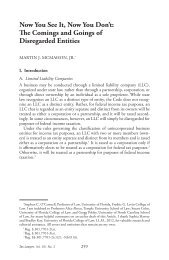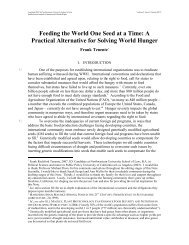The Reverse Triangular Merger Loophole and Enforcing Anti
The Reverse Triangular Merger Loophole and Enforcing Anti
The Reverse Triangular Merger Loophole and Enforcing Anti
You also want an ePaper? Increase the reach of your titles
YUMPU automatically turns print PDFs into web optimized ePapers that Google loves.
1046<br />
N O R T H W E S T E R N U N I V E R S I T Y L A W R E V I E W<br />
anti-assignment provision <strong>and</strong> to effectively assign contractual rights to the<br />
acquiring entity. Consent from third parties may be particularly difficult to<br />
secure when third parties resist consenting <strong>and</strong> dem<strong>and</strong> additional consideration.<br />
50 Finally, the acquiring entity must obtain every shareholder’s approval<br />
to effectuate the M&A transaction. 51<br />
In an effort to avoid contractual complications related to assignability<br />
issues, the reverse triangular merger has become a popular form of merger<br />
among corporate practitioners. 52 In a reverse triangular merger, the acquiring<br />
entity creates a subsidiary that merges with <strong>and</strong> into the target company;<br />
the target company survives <strong>and</strong> the subsidiary disappears. 53 <strong>The</strong> former<br />
target company’s shareholders receive acquiring entity voting stock in exchange<br />
for their target company stock, <strong>and</strong> the acquiring entity becomes the<br />
sole shareholder of the target company. 54 Thus, in a reverse triangular<br />
merger, only the ownership of the target company changes. <strong>The</strong> target<br />
company continues to exist <strong>and</strong> continues to own its own properties <strong>and</strong> assets<br />
following the merger, <strong>and</strong> no assets are transferred or contracts assigned<br />
to the acquiring entity. 55 Many commentators believe that this<br />
50<br />
From the acquiring entity’s point of view, it is very important to obtain third-party consent to assignment<br />
because the acquiring entity is liable for upholding the terms <strong>and</strong> conditions of the contract <strong>and</strong><br />
because the acquiring entity wants to avoid the possibility that the third party would have a cause of action<br />
for a breach or infringing use of the contract by the acquiring entity. See FREUND, supra note 16, at<br />
7-440; Rev. Rul. 77-428, 1977-2 C.B. Generally, the acquiring entity hopes to be able to conclude that<br />
consent is not needed so that the acquiring entity will not be forced to renegotiate aspects of the agreement<br />
or license as a quid pro quo for the other party’s granting consent to the assignment. See Richardson<br />
v. La Rancherita La Jolla, Inc., 159 Cal. Rptr. 285, 287 (Cal. Ct. App. 1979).<br />
51<br />
See 1 MARTIN D. GINSBURG & JACK S. LEVIN, MERGERS, ACQUISITIONS, AND LEVERAGED<br />
BUYOUTS 1002–04 (1993). Generally, approval from both the acquiring company <strong>and</strong> the target company’s<br />
stockholders are required to approve a forward triangular merger transaction. See SCHARF ET<br />
AL., supra note 19, at 7. Stockholders of both companies have the right to dissent from the transaction<br />
<strong>and</strong> be paid off in cash. Id. A large number of dissents may result in a substantial cash drain on the<br />
combined entity. Id.<br />
52<br />
See Glen A. Kohl & Lea Anne Storum, M&A Double Take: Why Two <strong>Merger</strong>s are Better than<br />
One, 5 M&A LAW. 1, 2–3 (2002) (acknowledging that acquirors may use the reverse triangular merger<br />
structure to “avoid the extra consents <strong>and</strong> resulting delays” that other business combinations might entail).<br />
See generally DALE A. OESTERLE, MERGERS AND ACQUISITIONS 25 (2006) (triangular mergers in<br />
general have become a very popular form of merger); Robert Willens, Flexibility of <strong>Reverse</strong> <strong>Merger</strong>s<br />
Increased by Regulations <strong>and</strong> Rulings, 70 J. TAX’N 52 (1989). For example, in the first quarter of 2006,<br />
there were 46 reverse triangular mergers, up from 43 in the first quarter of 2005. <strong>Reverse</strong> mergers totaled<br />
$1.31 billion in market capitalization in the first quarter of 2006. See Andrew Dolbeck, Alternative<br />
Offerings: Going Public with <strong>Reverse</strong> <strong>Merger</strong>s & SPACs, DEAL.COM, May 22, 2006,<br />
http://findarticles.com/p/articles/mi_qa3755/is_200605/ai_n17174211.<br />
53<br />
Aden R. Pavkov, Ghouls <strong>and</strong> Godsends? A Critique of “<strong>Reverse</strong> <strong>Merger</strong>” Policy, 3 BERKELEY<br />
BUS. L.J. 475, 478 (2006).<br />
54<br />
See PETER A. HUNT, STRUCTURING MERGERS & ACQUISITIONS: A GUIDE TO CREATING<br />
SHAREHOLDER VALUE 227–28 (2004).<br />
55<br />
See Use of Form S-8, Form 8-K, <strong>and</strong> Form 20-F by Shell Companies, Securities Act Release No.<br />
33-8587, Exchange Release No. 34-52038, 70 Fed. Reg. 42,234 (July 15, 2005); Use of Form S-8 <strong>and</strong><br />
Form 8-K by Shell Companies, Securities Act Release No. 33-8407, Exchange Act Release No. 34-<br />
49566, 69 Fed. Reg. 21,650, 21,652 (Apr. 21, 2004). Upon completion of the merger, the business op-


